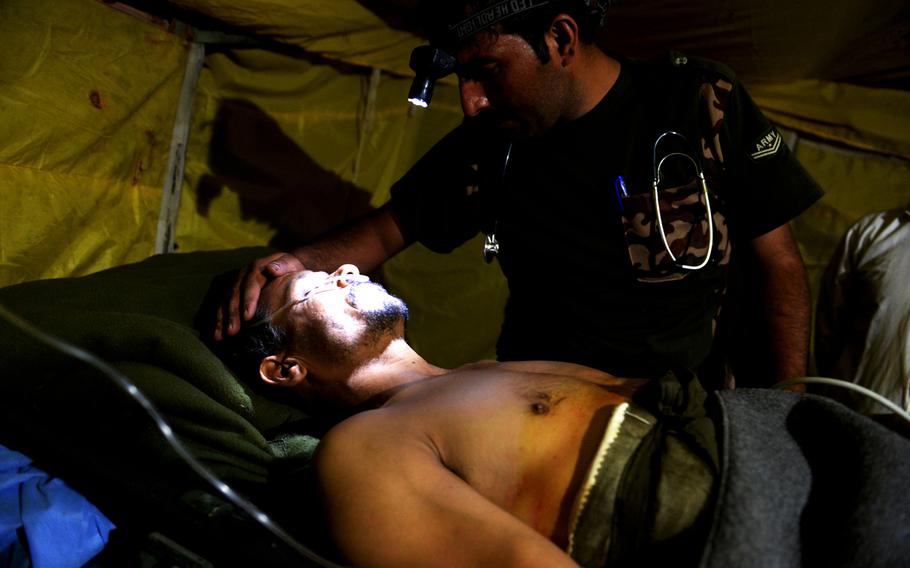
An Afghan army medic examines a local policeman who was critically injured last month when he was shot during a joint operation in Nangarhar province. Limited resources meant the army could not evacuate him to a better hospital. (Josh Smith/Stars and Stripes)
NANGARHAR PROVINCE, Afghanistan — Under the dim light of a single bulb, a local Afghan policeman lay severely injured, slipping in and out of consciousness. A military doctor reported to an Afghan army brigade commander that the man was unlikely to live through the night.
Despite the doctor’s pleas, the commander stood firm. The army could not spare any soldiers or ambulances to make the five-hour drive to a better hospital at that late hour through territory teeming with Taliban ambushes and roadside bombs.
The lack of speedy evacuation is a tragically common problem for the rising number of Afghan police and soldiers being injured on the battlefields of Afghanistan. U.S. advisers have worked to help close the capability gap, but mostly behind the scenes, far from the battlefields where many Afghan troops say they increasingly feel alone.
Although the American forces still stationed in the country have conducted more than 200 airstrikes since their combat mission was declared over at the end of 2014, as of July, U.S. military aircraft had not flown a single conventional medical evacuation mission, according to data released by the U.S. Air Force Central Command.
U.S. military officials say they haven’t flown evacuation missions because they haven’t been asked. Also, there are far fewer American resources available for such missions now.
Officially, Afghan leaders say they don’t need any help. The nascent Afghan air force has increased its medevac flights to about 1,250 in the first six months of 2015, compared to roughly the same number in all of 2014, according to the NATO-led coalition. Many of those missions are flown between existing airports, and not from the battlefield itself.
“As part of this mission, the commander of U.S. forces in Afghanistan has the authority to provide enabler support to the ANDSF in some circumstances, to include medical evacuation,” said Col. Brian Tribus, spokesman for the U.S. mission. “However, we do have a much smaller coalition footprint, therefore less assets and resources to provide such support. Additionally, we have not been asked to provide support in many cases largely due to the fact that ... the Afghan air force has consistently been growing and improving their medical capabilities.”
But even a short stay among the men on the front lines of the bloody fight with Taliban and other insurgents reveals that it’s not enough.
“I know why the Americans left us. It’s not their war,” said Mohammed Stanikzai, a young soldier tasked with escorting ambulances from the front lines. “But we’re not ready yet. It feels like we’re all alone.”
Even in the Afghan army, which is much better equipped than the police forces that suffer the most casualties, the vast majority of evacuations occur by land. Such trips often not only take many precious hours, but may also lead to more casualties as rescuers brave roads laced with improvised bombs and other hazards.
Military doctors say the delays are costing lives. “We do everything we can here, but it’s not enough,” said the army doctor treating the wounded policeman. “We have plenty of other supplies and medicine, but it doesn’t matter if we can’t get them to a hospital quickly. There’s only so much I can do here,” said the doctor who asked not to be named because he wasn’t authorised to discuss casualties.
It was a lesson U.S. forces learned the hard way during their wars in Afghanistan and Iraq. Medical teams pushed hard to get injured troops to the best care possible as soon as possible, a window of time often referred to loosely as the “Golden Hour.”
With a massive fleet of modern helicopters, trained medical crews, and state-of-the-art facilities, as well as better armor and protective equipment, many wounded American servicemembers who might have died were saved. Statistics show that at the height of U.S. operations, wounded soldiers who lived to make it to a large hospital like the one at Bagram Air Field had a 98 percent chance of survival.
The difference between the capabilities of the Americans and the Afghans is evident in the ratios of those killed and those who survived their wounds. About 2,363 Americans have died in Afghanistan, with a little more than 20,000 wounded, a ratio of roughly 1-to-10.
In the first half of 2015 alone, 4,302 Afghan soldiers and police were killed in action and 8,009 more were wounded, a ratio of about 1-to-2.
Among the relatively ill-equipped police forces, the toll is often the highest. When ANSF casualties spiked by 80 percent in the first few months of 2015 compared to the previous year, most of those were police, according to the Pentagon.
Bismullah Hagmal, a 24-year-old policeman from Kandahar, said doctors had to amputate his leg after he was injured by a roadside bomb along the border with Pakistan. His 10-hour journey to the nearest hospital was a relay race of multiple vehicles driven by police colleagues and family members.
Back in the tent in Nangarhar, the injured policeman’s comrades also decided to take matters into their own hands.
“We have spent the last seven or eight years risking our lives here,” said the injured policeman’s brother, who also serves in the local militia. “After all that, the government should at least help us.”
Frustrated by the lack of help from the army, they loaded the wounded man into the back of a truck to make the long midnight ride to a hospital near Jalalabad.
Hamidullah contributed to this report.
smith.josh@stripes.com Twitter: @joshjonsmith